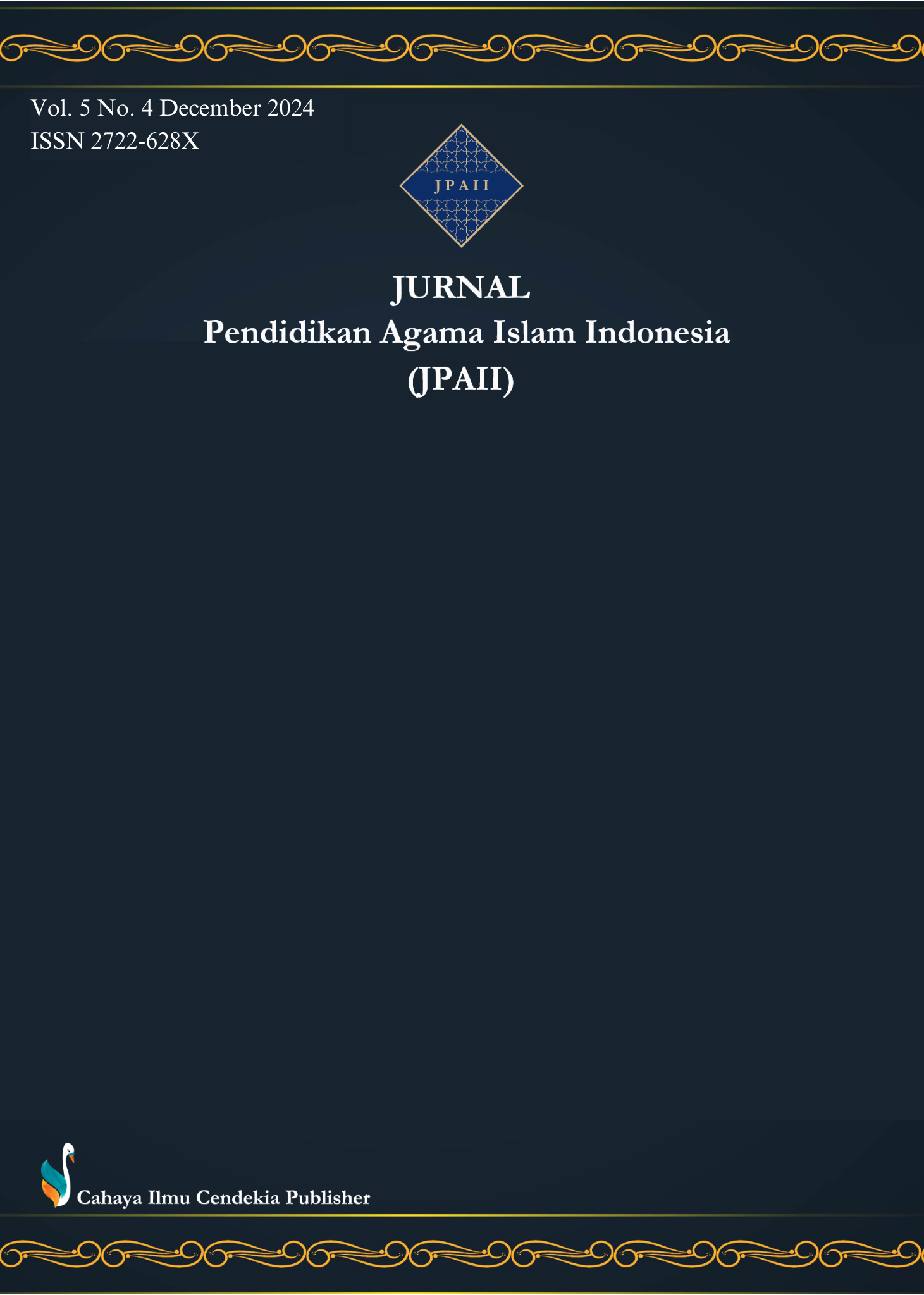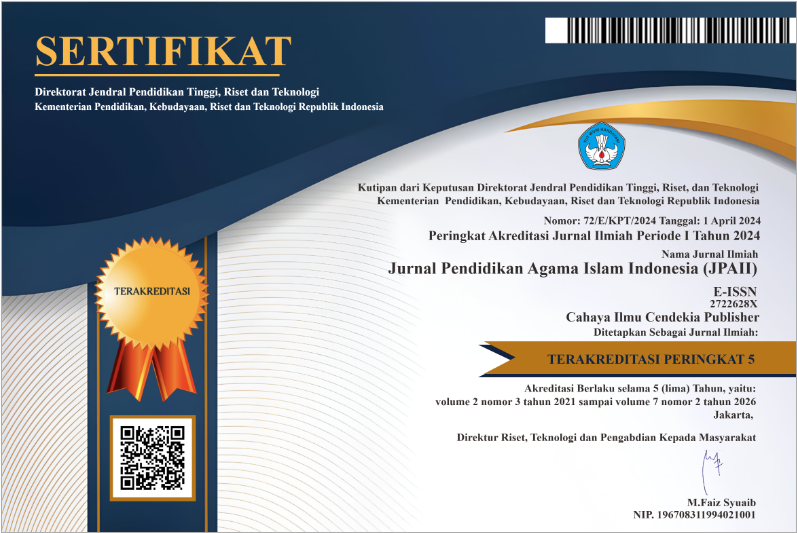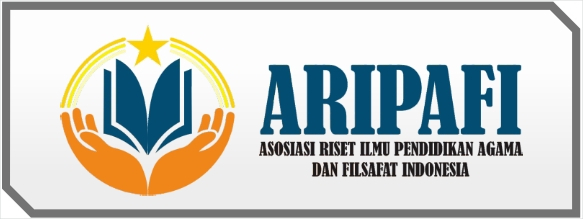Implementation of Online Learning for Islamic Cultural History Subjects
Abstract
Purpose of the study: : This study aims to provide an overview of the process and results of implementing online learning of Islamic cultural history subjects at State Islamic High School 2 Cilacap.
Methodology: The type of research used by the researcher in this study is field research using a qualitative descriptive approach.
Main Findings: The results of this study include the objectives of online learning of Islamic cultural history subjects at State Islamic High School 2 Cilacap which consists of e-learning-based learning to make learning materials available to others. The benefits of online learning to overcome space and time limitations between teachers and students. The advantages and obstacles of online learning.
Novelty/Originality of this study: The novelty of this study lies in its specific focus on Islamic Cultural History as part of religious education in Madrasah Aliyah, with an e-learning approach that utilizes a static station model to overcome the limitations of learning time.
References
S. Zhao, Y. Guan, H. Zhou, and F. Hu, “Making digital technology innovation happen: The role of the CEO's information technology backgrounds,” Economic Modelling, vol. 140, p. 106866, 2024, doi: 10.1016/j.econmod.2024.106866.
M. F. Firmansyah, M. I. Rizqulloh, and H. Z. Maulana, “Study of information communication technology and economic growth performance in Southeast Asian countries,” International Journal of Engineering, Science and Information Technology, vol. 1, no. 2, pp. 104–113, 2021, doi: 10.52088/ijesty.v1i2.121.
V. Voronkova, V. Nikitenko, R. Oleksenko, R. Andriukaitiene, J. Kharchenko, and E. Kliuienko, “Digital technology evolution of the industrial revolution from 4G to 5G in the context of the challenges of digital globalization,” TEM Journal, vol. 12, no. 2, pp. 732–742, 2023, https://www.ceeol.com/search/article-detail?id=1123025.
A. Y. Alqahtani and A. A. Rajkhan, “E-learning critical success factors during the COVID-19 pandemic: A comprehensive analysis of e-learning managerial perspectives,” Education Sciences, vol. 10, no. 9, p. 216, 2020, doi: 10.3390/educsci10090216
M. A. Almaiah, A. Al-Khasawneh, and A. Althunibat, “Exploring the critical challenges and factors influencing the e-learning system usage during COVID-19 pandemic,” Education and Information Technologies, vol. 25, pp. 5261–5280, 2020, doi: 10.1007/s10639-020-10219-y
A. M. Maatuk, E. K. Elberkawi, S. Aljawarneh, H. Rashaideh, and H. Alharbi, “The COVID-19 pandemic and e-learning: Challenges and opportunities from the perspective of students and instructors,” Journal of Computing in Higher Education, vol. 34, no. 1, pp. 21–38, 2022, doi: 10.1007/s12528-021-09274-2.
H. Cevahir, M. Özdemir, and M. H. Baturay, “The effect of animation-based worked examples supported with augmented reality on the academic achievement, attitude, and motivation of students towards learning programming,” Participatory Educational Research, vol. 9, no. 3, pp. 226–247, 2022, doi: 10.17275/per.22.63.9.3.
E. Barut Tugtekin and O. O. Dursun, “Effect of animated and interactive video variations on learners' motivation in distance education,” Education and Information Technologies, vol. 27, no. 3, pp. 3247–3276, 2022, doi: 10.1007/s10639-021-10735-5.
K. Kustyarini, S. Utami, and E. Koesmijati, “The importance of interactive learning media in a new civilization era,” European Journal of Open Education and E-Learning Studies, vol. 5, no. 2, 2020, doi: 10.46827/ejoe.v5i2.3298.
I. Yuhanna, A. Alexander, and A. Kachik, “Advantages and disadvantages of online learning,” Journal Educational Verkenning, vol. 1, no. 2, pp. 13–19, 2020, doi: 10.48173/jev.v1i2.54.
M. Ouadoud, N. Rida, and T. Chafiq, “Overview of e-learning platforms for teaching and learning,” International Journal of Recent Contributions to Engineering, Science & IT, vol. 9, no. 1, pp. 50–70, 2021, doi: 10.3991/ijes.v9i1.21111
R. Kumar, “Impact of COVID-19 pandemic on environment and society,” International Journal for Research in Applied Science and Engineering Technology, vol. 9, no. 2, pp. 114–118, 2021, doi: 10.22214/ijraset.2021.32984.
E. Santos, A. Diogo, V. Ratten, and F. Tavares, “The impact of the experiences on affects during the COVID-19 pandemic quarantine,” in COVID-19 and Entrepreneurship, Routledge, 2021, pp. 71–85, doi: 10.4324/9781003149248-6.
S. Irawan and L. Listyaningsih, “Persepsi mahasiswa terhadap pembelajaran daring,” Scholaria: Jurnal Pendidikan dan Kebudayaan, vol. 11, no. 3, pp. 216–225, 2021. https://ejournal.uksw.edu/scholaria/article/view/4299
L. Heryati, “Upaya meningkatkan pemahaman siswa kelas VIII melalui penggunaan media Google Classroom dalam pembelajaran jarak jauh IPA materi organ ekskresi semester genap tahun pelajaran 2021/2022,” Journal on Education, vol. 4, no. 3, pp. 968–979, 2022. https://jonedu.org/index.php/joe/article/view/511.
W. Winarto, A. Syahid, and F. Saguni, “Effectiveness the use of audio visual media in teaching Islamic religious education,” International Journal of Contemporary Islamic Education, vol. 2, no. 1, pp. 81–107, 2020, doi: 10.24239/ijcied.Vol2.Iss1.14.
C. Lange and J. Costley, “Improving online video lectures: learning challenges created by media,” International Journal of Educational Technology in Higher Education, vol. 17, pp. 1–18, 2020, doi: 10.1186/s41239-020-00190-6.
C. Coman, L. G. Țîru, L. Meseșan-Schmitz, C. Stanciu, and M. C. Bularca, “Online teaching and learning in higher education during the coronavirus pandemic: Students’ perspective,” Sustainability, vol. 12, no. 24, p. 10367, 2020, doi: 10.3390/su122410367.
S. Wahyuni, E. Erman, S. Sudikan, and B. Jatmiko, “Edmodo-based interactive teaching materials as an alternative media for science learning to improve critical thinking skills of junior high school students.” https://www.learntechlib.org/p/217835/.
S. Sripatmi, S. Azmi, J. Junaidi, N. P. Wulandari, and U. Lu’luilmaknun, “Learning media recommendations and criteria for the validity of junior high school mathematics learning media books,” JTAM (Jurnal Teori dan Aplikasi Matematika), vol. 7, no. 3, pp. 662–675, 2023, doi: 10.31764/jtam.v7i3.14907.
A. N. Azizah, T. A. Kusmayadi, and L. Fitriana, “Need assessment of mathematics learning module based on information technology for junior high school,” International Journal of Multicultural and Multireligious Understanding, vol. 7, no. 7, pp. 57–64, 2020, doi: 10.18415/ijmmu.v7i7.1715.
Y. Arikarani and M. F. Amirudin, “Pemanfaatan media dan teknologi digital dalam mengatasi masalah pembelajaran di masa pandemi,” Edification Journal: Pendidikan Agama Islam, vol. 4, no. 1, pp. 93–116, 2021, doi: 10.37092/ej.v4i1.296.
A. R. Meliyani, D. Mentari, G. P. Syabani, and N. Z. Zuhri, “Analisis kebutuhan media pembelajaran digital bagi guru agar tercipta kegiatan pembelajaran yang efektif dan siswa aktif,” Jurnal Jendela Pendidikan, vol. 2, no. 02, pp. 264–274, 2022, doi: 10.57008/jjp.v2i02.179.
S. N. Hayani and S. Sutama, “Pengembangan perangkat dan model pembelajaran berbasis TPACK terhadap kualitas pembelajaran daring,” Jurnal Basicedu, vol. 6, no. 2, pp. 2871–2882, 2022, doi: 10.31004/basicedu.v6i2.2512.
A. A. F. Hidayah, R. Al Adawiyah, and P. A. R. Mahanani, “Efektivitas pembelajaran daring di masa pandemi COVID-19,” Jurnal Sosial Jurnal Penelitian Ilmu-Ilmu Sosial, vol. 21, no. 2, pp. 53–56, 2020.
I. Hafizhah, I. A. Wardana, and D. I. Setiabudi, “Efektivitas penggunaan model pembelajaran quantum learning dalam upaya meningkatkan kemampuan psikomotorik pada pelajaran matematika,” Jurnal Riset Sosial Humaniora dan Pendidikan, vol. 1, no. 1, pp. 11–21, 2022, doi: 10.56444/soshumdik.v1i1.69.
V. J. Araujo, Y. J. W. Yuniarto, and A. J. Prayitno, “Efektivitas pembelajaran PAK dengan metode Teams Games Tournament berbantuan LKS terhadap prestasi belajar siswa kelas V SD Aloysius Semarang,” Jurnal Filsafat dan Teologi Katolik, vol. 7, no. 1, pp. 73–79, 2023, doi: 10.58919/juftek.v7i1.71.
Y. N. Dewi, M. Zaim, and Y. Rozimela, “Interactive learning using e-learning module in learning English for senior high school: A review of related articles,” JELITA: Journal of Education, Language Innovation, and Applied Linguistics, vol. 1, no. 2, pp. 125–134, 2022, doi: 10.37058/jelita.v1i2.5306.
B. Bukhatwa, E. N. A. Al Ruqeishi, and F. M. H. Al Khamisi, “The usefulness of technology-based interactive methods in teaching mathematics and statistics at the college level,” Shanlax International Journal of Education, vol. 10, no. 3, pp. 30–40, 2022. https://eric.ed.gov/?id=EJ1340904.
E. Risdianto and M. Zuki, “Development of online-based learning using Moodle e-learning system in new innovation and paradigm of education course,” in International Conference on Educational Sciences and Teacher Profession (ICETeP 2020), Atlantis Press, 2021, pp. 108–113, doi: 10.2991/assehr.k.210227.018.
O. K. T. Kilag, M. H. Malbas, J. R. Miñoza, M. M. R. Ledesma, A. B. E. Vestal, and J. M. V. Sasan, “The views of the faculty on the effectiveness of teacher education programs in developing lifelong learning competence,” Journal of Higher Education and Academic Advancement, vol. 1, no. 2, pp. 92–102, 2024, doi: 10.61796/ejheaa.v1i2.106.
J. E. R. Marantika, “Metacognitive ability and autonomous learning strategy in improving learning outcomes,” Journal of Education and Learning (EduLearn), vol. 15, no. 1, pp. 88–96, 2021. https://eric.ed.gov/?id=EJ1299455.
H. Tamsah, J. B. Ilyas, and Y. Yusriadi, “Create teaching creativity through training management, effectiveness training, and teacher quality in the COVID-19 pandemic,” Journal of Ethnic and Cultural Studies, vol. 8, no. 4, pp. 18–35, 2021, doi: 10.29333/ejecs/800.
N. Azizah, M. Zamroni, and R. R. Ginanjar, "Analisis kesulitan belajar dalam pemahaman konsep pembelajaran IPA Kelas IV di MI Hidayaturrohman Kecamatan Teluknaga Kabupaten Tangerang," Jurnal Pendidikan dan Konseling (JPDK), vol. 4, no. 5, pp. 2419–2425, 2022, doi: 10.31004/jpdk.v4i5.6968.
A. Parra et al., "Psychotic symptoms in COVID-19 patients. A retrospective descriptive study," Psychiatry Research, vol. 291, p. 113254, 2020, doi: 10.1016/j.psychres.2020.113254
A. N. Indah and E. Nurmaily, "Agoraphobia Analysis Experienced By the Main Character in Maria Semple’s Where’d You Go, Bernadette Novel," Linguistics and Literature Journal, vol. 3, no. 2, pp. 131–139, 2022, doi: 10.33365/llj.v3i2.2149.
I. Ismail, R. S. Putri, Z. Zulfadhli, A. Mustofa, M. Musfiana, and R. Hadiyani, "Student Motivation to Follow the Student Creativity Program," Riwayat: Educational Journal of History and Humanities, vol. 5, no. 2, pp. 351-360, 2022. doi: 10.24815/jr.v5i2.27641.
M. Alwi and L. Mumtahana, "The Principal's Strategy in Improving the Quality of Teacher Performance in the Learning Process in Islamic Elementary Schools," Kharisma: Jurnal Administrasi Dan Manajemen Pendidikan, vol. 2, no. 1, pp. 66-78, 2023. doi: 10.59373/kharisma.v2i1.18.
V. Žydžiūnaitė and A. Arce, "Being an innovative and creative teacher: passion-driven professional duty," Creativity Studies, vol. 14, no. 1, pp. 125-144, 2021. doi: 10.3846/cs.2021.14087.
A. D. Rahman, M. M. Musa, and J. Rini, "Interactive Learning Media Innovation PPT Video Animation in Improving Critical Thinking MI/SD Students in The 21st Century Era," in Proceeding International Conference on Islam and Education (ICONIE), vol. 2, no. 1, pp. 151-163, Jul. 2022.
F. R. Rahim, S. Y. Sari, P. D. Sundari, F. Aulia, and N. Fauza, "Interactive design of physics learning media: The role of teachers and students in a teaching innovation," Journal of Physics: Conference Series, vol. 2309, no. 1, p. 012075, Jul. 2022. doi: 10.1088/1742-6596/2309/1/012075.
A. Adiyono and A. M. Anshor, "Islamic character education in the era of Industry 5.0: Navigating challenges and embracing opportunities," Al-Hayat: Journal of Islamic Education, vol. 8, no. 1, pp. 287-304, 2024. doi: 10.35723/ajie.v8i1.493.
S. P. Saleh, H. Cangara, S. Sabreen, and S. Ab, "Digital da’wah transformation: Cultural and methodological change of Islamic communication in the current digital age," International Journal of Multidisciplinary Research and Analysis, vol. 5, no. 8, pp. 2022-2043, 2022. doi: 10.47191/ijmra/v5-i8-18.
Copyright (c) 2024 Sulaiman Sulaiman, Saedul Ahmad Fauzi, Fajar Indriyani, Raed Fakhri Abulatifeh

This work is licensed under a Creative Commons Attribution 4.0 International License.
Authors who publish with this journal agree to the following terms:
- Authors retain copyright and acknowledge that the Jurnal Pendidikan Agama Islam Indonesia (JPAII) is the first publisher licensed under a Creative Commons Attribution 4.0 International License.
- Authors are able to enter into separate, additional contractual arrangements for the non-exclusive distribution of the journal's published version of the work (e.g., post it to an institutional repository or publish it in a book), with an acknowledgment of its initial publication in this journal.
- Authors are permitted and encouraged to post their work online (e.g., in institutional repositories or on their website) prior to and during the submission process, as it can lead to productive exchanges and earlier and greater citation of published work.







.png)
.png)





















